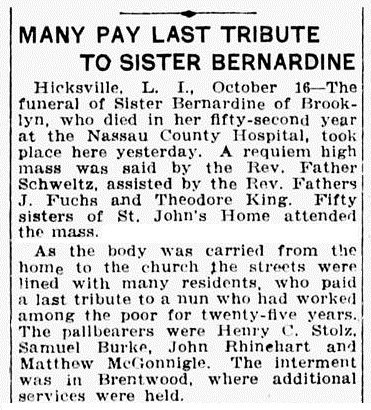Protectory Life
The annual reports of the Orphan Asylum Society, read in combination with contemporary news stories, give us some inkling of life within the Protectory's walls.
The facility's capacity was usually given as 125 boys. Nuns were the core of the administration and educational staff; other positions, from choir director to farmhand, seem to have been held by men. The total number of adults on hand cannot be known from the annual reports of the Society, which lump together staffing figures for Brooklyn and Hicksville. As one would expect, schooling, farm work, and career training constituted the greater part of the boys' routines. The farm's annual gross revenue seems impressive - $4,500 in 1892, as an example - but the annual expense of educating, housing, clothing, and feeding more than 100 boys also must have been impressive. Career training was taken seriously - at the time the annual report was prepared, a number of boys had been sent to Ohio to learn "fancy glass making" from manufacturers.
Health was a concern. By the 1890s, the world was acquiring a better understanding of how diseases spread. The Society decided that its larger residences, which housed hundreds of children, should have "quarantine rooms," in which sick children could be isolated before their illness spread. Putting the new rooms in the most crowded facilities may have made a difference: there was a polio epidemic in the summer of 1916, but not one of the 1,700 children in the Society's facilities contracted the disease.
Quarantine rooms seem not to have been fitted into the Protectory, a non-decision which later may have proved significant. The global influenza of 1918-1919 was more highly contagious than polio, and at one point, at least half the boys in the Protectory, as well as a number of the adults on staff, were simultaneously ill with the "Spanish flu." The newspapers reported no deaths among the boys (which does not necessarily mean that none of them died), but one nun, the well-liked Sister Bernadine, did die of influenza. She had had spent a quarter century - her entire career of service as a nun - at the Protectory.
On the day of her Requiem Mass at St. Ignatius, townsfolk respectfully gathered along the route to view the cortege that bore her remains south to the church from the home. Clearly, the village did not consider those at the Protectory to be outsiders.

Excerpt of article from The Brooklyn Daily Eagle, October 16, 1918
***

